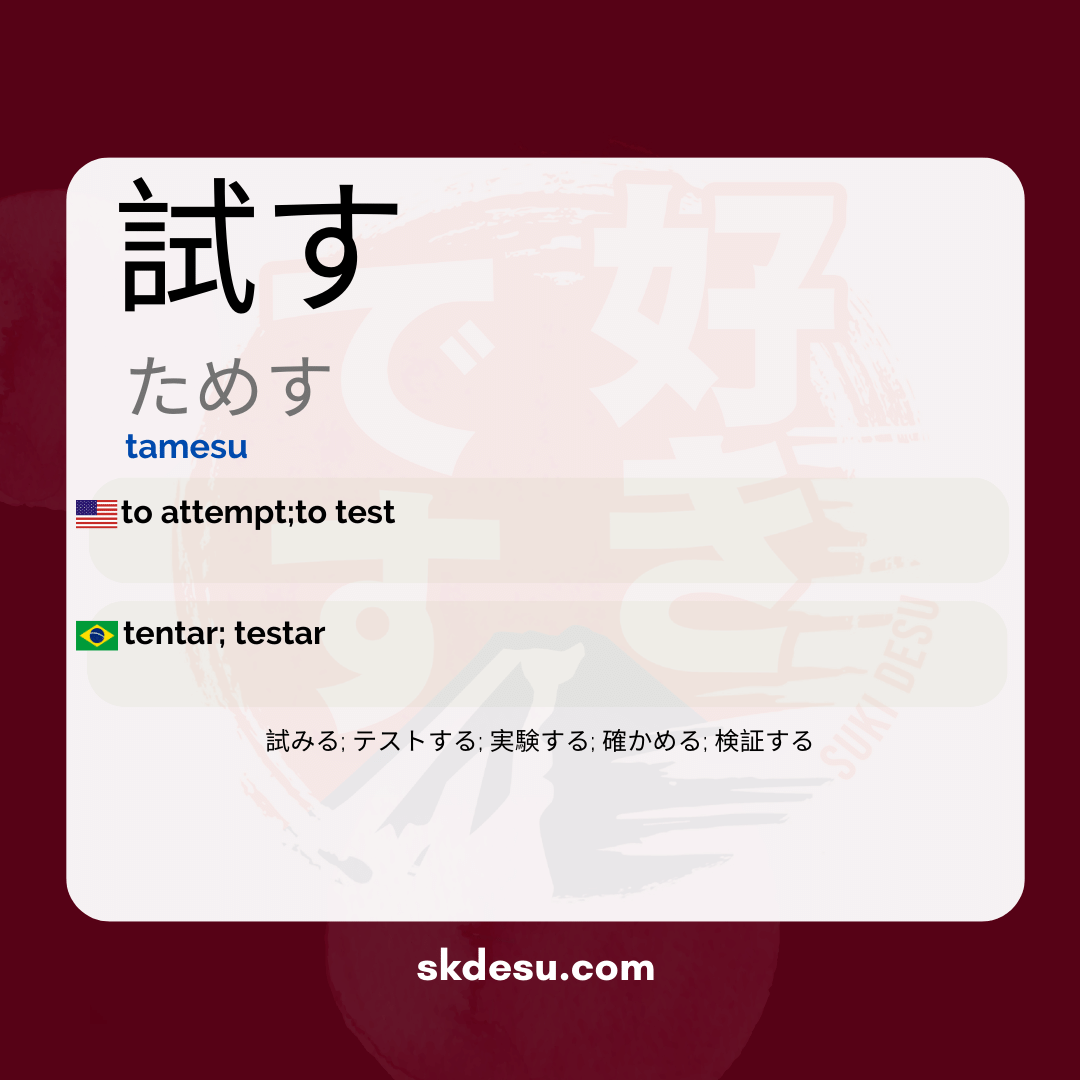Translation and Meaning of: 試す - tamesu
The Japanese word 試す (ためす) is a common verb that means "to test," "to try," or "to prove." If you are studying Japanese or are curious about the language, understanding its meaning, usage, and cultural context can be very helpful. In this article, we will explore everything from its origin and writing to everyday situations where this word appears. Additionally, we will look at how to memorize it effectively and some interesting facts that make its learning more engaging.
試す is a versatile term, present in everyday conversations and even in more formal contexts. Whether to test a new product, try out a recipe, or even prove a theory, this verb has practical applications worth knowing. Let's dive into the details so you can use it confidently in your Japanese interactions.
Meaning and use of 試す
The verb 試す carries the idea of putting something to the test, whether it's an object, an idea, or even a skill. It can be used in both concrete situations, like testing an electronic device, and in abstract contexts, such as trying a different method. For example, when saying "この方法を試してみたい" (I want to try/test this method), the speaker shows interest in experimenting with something new.
An interesting characteristic of 試す is that it often appears combined with other verbs, such as 試してみる (try to test) or 試す価値がある (worth testing). These constructions expand its meaning and show how the Japanese language allows for subtle nuances of expression. It is an active verb that invites action and discovery.
Origin and writing of the kanji 試
The kanji 試 is composed of two main elements: the radical 言 (which relates to speech or language) and the component 式 (which can indicate style or method). This combination suggests the idea of "putting into words" or "evaluating a method," which aligns well with the meaning of testing or trying out. The reading ためす is one of the kun'yomi (Japanese readings) of this character.
Interestingly, the same kanji can also be read as シ (shi) in words like 試験 (しけん, exam) or 試合 (しあい, sports match). This duality of readings is common in Japanese and highlights the importance of learning both the meaning and the context in which the characters appear. To memorize 試す, a tip is to associate it with testing or experimentation situations you have experienced.
Try in Japanese culture and daily life
In Japan, the practice of testing before buying is highly valued, especially in electronics or cosmetic stores. Phrases like "試してみてもいいですか?" (May I try it out?) are common in these settings. This culture of experimentation reflects a broader aspect of Japanese society, which often prioritizes certainty and reliability before making definite commitments.
In professional contexts, 試す often appears in discussions about product development or process improvement. Japanese companies tend to emphasize the testing phase before launch, which shows how the verb is connected to important values in the work world. Observing these usages can help students understand not only the language but also aspects of the Japanese mindset.
Vocabulary
Expand your vocabulary with related words:
Synonyms and similar words
- 試みる (kokoromiru) - Try, experiment
- テストする (tesuto suru) - Test, carry out a test
- 実験する (jikken suru) - Conduct an experiment
- 確かめる (tashikameru) - Confirm, verify
- 検証する (kenshō suru) - Verify, validate (in a more rigorous context, such as scientific testing)
Romaji: tamesu
Kana: ためす
Type: noun
L: jlpt-n3
Translation / Meaning: to try; test
Meaning in English: to attempt;to test
Definition: To really experience something and confirm its effects and outcomes.
Quick Access
- Vocabulary
- Writing
- Sentences
How to Write in Japanese - (試す) tamesu
See below a step-by-step guide on how to write the word by hand in Japanese. (試す) tamesu:
Example Sentences - (試す) tamesu
See below some example sentences:
Watashi wa atarashii reshipi o tamesu koto ga suki desu
I like to try new recipes.
I like to try a new recipe.
- 私 (watashi) - Japanese personal pronoun that means "I"
- は (wa) - Japanese particle that indicates the topic of the sentence
- 新しい (atarashii) - 新しい (atarashii)
- レシピ (reshipi) - Japanese noun that means "recipe".
- を (wo) - Japanese particle that indicates the direct object of the sentence
- 試す (tamesu) - Japanese verb that means "to try" or "to test"
- こと (koto) - Japanese noun that means "thing" or "action"
- が (ga) - Japanese particle that indicates the subject of the sentence
- 好き (suki) - Japanese adjective that means "like"
- です (desu) - Japanese auxiliary verb that indicates present tense and formality of the sentence
Kono ryōri wa hajimete tameshimashita
I tried this dish for the first time.
I tried this dish for the first time.
- この - demonstrative pronoun that means "this" or "this here"
- 料理 - noun that means "cuisine" or "dish"
- は - Particle indicating the topic of the sentence
- 初めて - adverb meaning "for the first time"
- 試しました - The verb in the past that means "I tried" or "I tasted"
Other Words of this Type: noun
See other words from our dictionary that are also: noun

